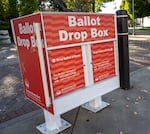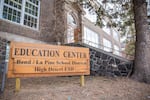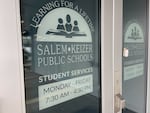
A ballot drop box in Deschutes County, Ore.
Courtesy of Deschutes County
Six of Oregon’s ten largest school districts either have a local option levy in place or are seeking one on the May ballot.
Beaverton, North Clackamas and Tigard-Tualatin already have levies that help pay for teachers and other aspects of school operations. Portland, Bend-La Pine and Eugene have measures on the current ballot to either establish or renew levies in their communities.
These taxes have become a key part of education funding in the state.
Oregon funds schools through a combination of local, state and federal money. State funding makes up the biggest chunk of district budgets and is largely based on a weighted per-student formula — in other words, districts are paid based on how many students they serve.
Local option levies are a way for schools to generate additional revenue to pay for school operations — to fund programs, reduce class sizes or meet other education priorities.
“A local option levy is probably one of the only ways that [districts are] able to generate that additional amount of money because schools don’t really have any say in [the state funding] formula,” said Jenny Liu, a Portland State University professor who specializes in economics and public policy.
“It’s a formula,” Liu said, “which I think does try to keep things fair and equitable, but it’s maybe contentious and perhaps needs to be looked at again.”
Different from construction bonds, which have to be used for facility improvements, school officials have more discretion when it comes to local option levies. Districts with levies have used the supplemental money to hire teachers to reduce class sizes or to support special programs. A quick way to remember the difference: Bonds are for buildings. Levies are for learning.
How Oregon funds schools — think income taxes and local property taxes — has been the way of things for years. But it hasn’t always been that way.
Some 30 years ago, a series of anti-tax ballot measures fundamentally changed the school funding equation.
Related: Oregon school funding is complicated. We try to break it down
Measure 5, passed by voters in 1990, created a new limit on what portion of local property taxes could be spent on schools. And Measure 50, passed seven years later, further limited how quickly local property taxes could increase.
These measures are a big part of why districts lean on local option levies the way they do now, even with the restrictions. But they’re also why some districts ultimately can’t take advantage.
Liu said the appetite for local option levies can often depend on who else is asking voters for money in a given election, making it hard to predict the outcome.
“If there are multiple levies, say, the school district local option levy, combined with the fire district levy, combined with a zoo levy, that are all on a ballot,” she said, “it starts to influence the voters’ perception of all of the things that they’re being asked to pay for.”
As districts across the region face significant budget cuts this spring, this local funding stream could make or break the financial stability of several Oregon schools.
Portland seeks renewal of levy to pay for teachers
Oregon’s largest school district is asking voters this month to renew a five-year local option levy that otherwise expires in June 2025.
The ballot measure would renew Portland Public Schools’ current property tax rate of $1.99 per $1,000 of assessed property value. That’s separate from PPS bond funds most recently approved by voters in 2020. A home’s assessed value is different and typically lower than what a house could be sold for, also known as “market value.”
According to the district’s levy information page, the owner of a home assessed at about $275,700 — which they said is the district’s current average — would pay about $45 per month or roughly $548 per year for the renewed levy.
The district estimates this money would bring in $101.5 million in tax revenue in its first year.

Emilie Elobt, a teacher at Sitton Elementary in Portland, welcomes students into her classroom on the first day of school on August 29, 2023. Elobt had hugs and high-fives for students she had in past years and new students in her classroom.
Caden Perry / OPB
The money collected over five years would fund about 660 teachers and classroom support staff, according to PPS, and benefit every school across the district.
The current levy reportedly paid for 851 positions in the 2022-23 fiscal year. However, because of an anticipated drop in revenue due to changes in the Portland real estate market and increased personnel costs, the renewed levy wouldn’t pay for as many educators.
Without the levy funds, PPS would be faced with a $100 million budget gap for the 2025-26 school year, and officials said that would likely mean a significant reduction in teaching staff.
The district is already facing a $30 million deficit for the upcoming school year, expecting to cut some 250 positions districtwide.
Related: Q&A: Portland Public Schools considers a nearly $2.4 billion budget proposal for next year
If the option levy doesn’t pass this spring, officials said they will put the measure back on the ballot again in November.
At the same time, PPS leaders, including the school board, see a broader problem with how Oregon funds schools.
Along with other large districts, they have voiced their call to action for state leaders, including Gov. Tina Kotek and the legislature, to review and change the state school funding formula before the 2025 legislative session.
Without big changes at the state level, more individual districts are looking to shore up their school programs with the main tools available.
Bend-La Pine seeks levy to maintain class sizes, recruit and retain teachers
Officials in the Bend-La Pine School District say they’re unable to fully fund student-focused programs and services with the money the district currently receives from the state.
So, they’re proposing a new five-year local option levy they say will allow the district to bridge the gap.
Related: Bend-La Pine Schools pitches 5-year levy to meet needs
If approved, the levy would establish a tax rate of $1 per $1,000 of assessed property value.
The district gave an example of how that would affect a local homeowner: The estimated cost for a home with a median assessed value of $238,750 is about $239 a year.
The levy would provide Bend-La Pine more than $21 million in the first year.
District leaders said the money would protect and maintain class sizes, strengthen and add career technical education opportunities, and improve support systems for struggling students, among other things.

The Bend-La Pine School District is expected to grow by 3,000 students in the next 10 years.
Bradley W. Parks / OPB
If the levy doesn’t pass, taxes won’t go up, but the largest district east of the Cascades would be forced to make budget cuts.
The district anticipates needing to eliminate up to 180 positions over the next two years. Average class sizes would increase by four students. And demands for advanced courses, electives, student services and career tech would “continue to outpace district resources.”
“[The levy] will provide the world-class schools our students, families and our community deserve,” Melissa Barnes Dholakia, then-board chair for Bend-La Pine, said earlier this year. She told KLCC that this is the first levy the district will put before voters in 20 years. The district went out for one in 2004, she said, but it didn’t pass.
“Our community has changed quite a bit,” she said, “so we feel like it is the right time ... to come forward again to all of the residents of Bend-La Pine school district and say, ‘Let’s revisit this, this is something that we want for our community.’”
For Salem-Keizer, a local option levy isn’t really an option at all
While other districts push for these extra funding streams, some ultimately can’t — namely Oregon’s second-largest district, Salem-Keizer Public Schools.
Salem-Keizer is based in the state’s capital, meaning there’s more state-owned, tax-exempt real estate. In other words, it’s not that Salem-Keizer couldn’t go for a local option levy, but it wouldn’t generate enough money to be worth the cost to property owners.
“Local option levies are great options for communities with high property value and low compression,” said Aaron Harada, director of communications for Salem-Keizer. “Unfortunately, Salem has heavy compression due, in part, to being the state capital: 8% of state-owned, tax-exempt real estate.”
“Compression” is a complicated structure governing tax percentages based on limits set under Measures 5 and 50. Compression can lead to some taxing authorities — such as schools — getting less than the full revenue amount they were seeking.
“We are nearing the point at which local option levy funding is the norm,” Harada told OPB in an email. “As the state’s second-largest and least wealthy community, we are actively disadvantaged by the absence of local option levy funding.”

The Salem-Keizer Public Schools logo photographed outside the district's Student Support Services Center on Dec. 7, 2023, in Salem, Ore.
Natalie Pate / OPB
Districts other than Salem-Keizer might avoid seeking local options as well because the measures could be too expensive, politically unpopular, or both.
PSU professor Liu’s advice to voters? Take a close look at your own property tax bill to gauge exactly how much you’re going to pay. She also noted that if homeowners are subject to an increase in property values, some of that expense will be passed down to renters, so they should stay up to date on changes, too.
Learn more about bonds and local option levies from the Oregon School Boards Association’s FAQ. Information on the May election can be found on the Secretary of State’s website.
